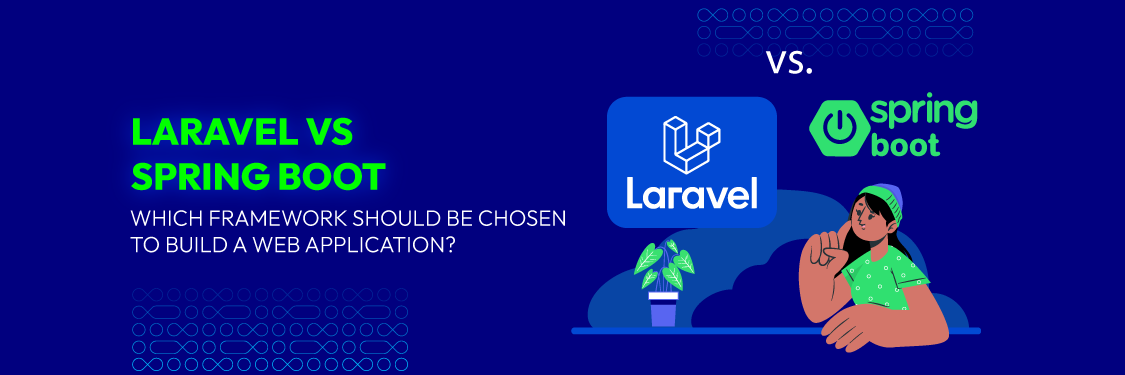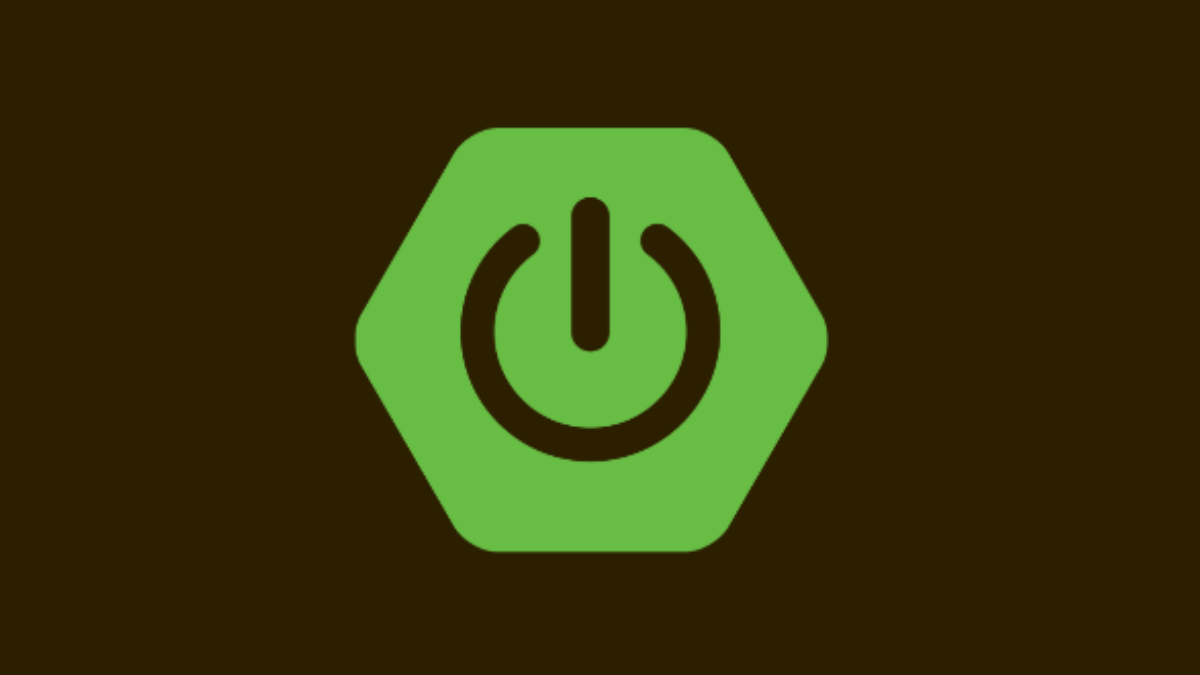Laravel vs Spring Boot - Which framework should be chosen to build a web application?
Summer Nguyen | 04-23-2024

What is the suitable framework for developing a web?
There are many solutions to that question. And Laravel vs Spring Boot are two of the most competitive options for users.
This post will compare the pros and cons of Laravel vs Spring Boot to help web developers choose the suitable framework.
Which is Laravel?
Laravel is a popular framework used for building websites. Like a toolbox, Laravel helps users design the web quickly and easily. Laravel follows the MVC (Model-View-Controller) architectural framework. This provides developers with an organized method to create a flexible and maintainable web.

Laravel has some advantages and disadvantages that need to be considered when choosing.
Advantages
- Easy to Learn: Because of clear and simple instructions, Laravel is very suitable for beginners to use.
- Saves Time: Laravel has a lot of built-in functions. This will help users save time and effort to write code.
- Secure: Laravel includes built-in security functions to protect websites from threats like hacking and unauthorized access.
- Active Community: Laravel has many users. So you can ask for support if you want.
- Modern Features: Laravel keeps up with the latest trends in web development, allowing users to build webs using modern techniques and tools.
Disadvantages
- Requires Server: Laravel needs a server to run. That will lead to an extra step in your process.
- Compatibility Issues: There will be some problems when updating the new version of Laravel. It can cause troubles with current code or other software.
- Learning Curve: Sometimes Laravel is more advanced which leads to difficulty for beginners.
- Performance: There are some claims about the efficiency of the web built by Laravel, especially for very large or busy sites.
- Dependence on Libraries: Because of depend on other pieces of software known as libraries, Laravel can be caused conflicts.
In conclusion, Laravel is a great choice because of its ease of learning, time-saving, and useful functions. However, It still has some limitations that you need to consider.
Which is Spring Boot?
Spring Boot is a framework for building Java apps, especially web applications and small services. It helps developers create Java programs quickly and with less hassle trouble.

Users can choose if Spring Boot is suitable by analyzing the pros and cons of this framework.
Advantages
- Easy to Start: Spring Boot provides tools for beginners to get acquainted with Java programming.
- Saves Time: Like Laravel, Spring Boot has a lot of built-in functions. This will help users save time and effort to write code.
- Flexible: Spring Boot lets developers choose the parts they need for their project, so they can customize their applications to work just the way they want.
- Great Community: Many people are using Spring Boot. So your questions will be answered if requested for support.
- Reliable: Users can work well on their projects because of the reliability and dependability of Spring Boot.
Disadvantages
- Complexity: Newbies to Java programming will find Spring Boot difficult to understand.
- Performance: As Laravel, Spring Boot webs can be slower than ones built by other frameworks, especially for very large or busy projects.
- Updates: There are some issues with old code or other software when you update Spring Boot.
- Requires Setup: Spring Boot only runs when users set up suitable software, which can be challenging for beginners.
- Learning Curve: Like any new tool, Spring Boot has a learning curve. Users may need some time to get used to it.
In conclusion, Spring Boot is a popular tool used for building web. But It will have some disadvantages you need to consider.
Detailed comparison between Laravel vs Spring Boot
Laravel vs Spring Boot are both popular frameworks used for building web apps. But, there are some differences in how they’re used. You can refer to the following table to make the decision about which one is suitable:
| Feature | Laravel | Spring Boot |
|---|---|---|
| Language | PHP | Java |
| Framework Type | Full-Stack Web Framework | Java-based Microservice |
| Architecture | Follows MVC pattern | Supports standalone applications with minimal configuration |
| ORM | Eloquent ORM | Spring Data JPA |
| Templating Engine | Blade | Thymeleaf, FreeMarker |
| Command Line Tool | Artisan | Spring Initializr |
| Community Support | Active Laravel Community | Vibrant Spring Community |
| Market Share | Widely used in PHP development | Widely used by Java developers |
| Learning Curve | Moderate | Moderate to Steep |
| Performance | Lightweight and efficient | Speed and scalability |
| Ease of Configuration | Provides clearer conventions | Offers robust auto-configuration |
| Integration Ecosystem | Composer Packages | Spring Ecosystem (Like Spring Cloud, Spring Security) |
This table summarizes Laravel vs Spring Boot’s primary differences in their key features: languages, frameworks, and community support. Detailed information about those features is summarized below in this post.
About Language and Ecosystem
Laravel vs Spring Boot have different languages and ecosystems:
- Laravel: Written in PHP. It is a popular framework in the PHP ecosystem and provides many features as well as a community with numerous packages and extensions.
- Spring Boot: Used Java language. Spring Boot is part of the Spring ecosystem, that is used by enterprise-level Java developers. It has many libraries and tools to support users.
In conclusion, Laravel vs Spring Boot are based on different languages and ecosystems. Each one has its strengths, characteristics, and community support, that is suitable for different development needs and preferences.
Ease of Learning
When it comes to ease of learning, Laravel vs Spring Boot offer different experiences due to their respective programming languages and frameworks:
- Laravel: Laravel has clean syntax and full documentation that is very useful for beginners, especially those familiar with PHP.
- Spring Boot: While Spring Boot offers full documentation, Java has a harder learning curve, especially for beginners.
In summary, while both Laravel vs Spring Boot provide tools and features, Laravel may be more user-friendly for beginners due to its clean syntax and full documentation.
Java experience developers may find Spring Boot supportive in their learning journey. Anyway, the choice between Laravel and Spring Boot depends on the needs of users and their familiarity with which framework.
Development Speed
Development speed refers to how quickly developers can create and build applications using a particular framework. About the development speed of Laravel vs Spring Boot:
- Laravel: Laravel promotes rapid application development with some features, such as Artisan CLI and built-in templates. It enables users to create web quickly.
- Spring Boot: Spring Boot’s convention-over-configuration approach and starter dependencies make development easier. Although Java’s verbosity compared to PHP can slightly impact development speed.
So, Laravel is the best choice for beginners because of its simplicity and pre-built features. On the other hand, Spring Boot is more suitable for enterprise developers, because of its convention-over-configuration
Depending on the requirements of the projects, you can choose between Laravel and Spring Boot.
Community and Support
Community and support are crucial to the success and adoption of any framework. Let’s explore the community and support aspects of Laravel and Spring Boot:
- Laravel: Laravel has a large and active community to support users excellently.
- Spring Boot: As one of the Spring ecosystems, Spring Booth benefits from providing tools and support for developing enterprise-grade apps.
Both Laravel and Spring Boot have strong and supportive communities for users. Developers can rely on these communities for assistance, guidance, and collaboration throughout their journey with the respective frameworks.
Performance
Performance is a critical aspect to consider when choosing a framework for building applications. Let’s compare the performance characteristics of Laravel and Spring Boot:
- Laravel: While Laravel offers good performance for most projects, PHP’s interpreted nature may lead to lower performance than compiled languages like Java.
- Spring Boot: With the performance optimizations provided by the Java Virtual Machine (JVM) and the Spring framework, Spring Boot applications often exhibit robust performance.
In conclusion, Laravel is the best framework for building basic webs. Spring Boot is a better choice for building a complicated web with high performance.
Scalability
Scalability is the framework’s ability to handle increased workload by adding resources or making architectural adjustments. Compare this aspect in both Laravel and Spring Boot:
- Laravel: Laravel applications can be extended horizontally by adding more servers or vertically by upgrading hardware. However, PHP’s single-threaded nature may limit scalability in some scenarios.
- Spring Boot: Because of Java’s multi-threading capabilities and cluster support, Spring Boot Apps are highly scalable and suitable for handling heavy loads and traffic volumes.
In conclusion, Spring Boot can support almost complicated cases. The choice between 2 frameworks will depend on the specific requirements of project.
Use Cases
The use cases of Laravel vs Spring Boot can help us understand where each framework excels:
- Laravel: Laravel is perfect for features that focus on developer productivity and ease of use like developing web apps, content management systems (CMS), and small-scale projects.
- Spring Boot: Spring Boot is suited for some platforms that require high performance, scalability, and reliability.
In conclusion, Laravel is the best for those who prioritize performance while Spring Boot is suited for enterprise-level developers.
The choice between Laravel and Spring Boot depends on some aspects such as project requirements, developer experience, and ecosystem preferences.
Using Laravel or Spring Boot for building a web application?

Choosing between Laravel and Spring Boot for building a web application can be considered carefully. Both frameworks have their advantages and disadvantages which help them be suitable for the different needs of users.
Consider some aspects before choosing a suitable framework for building a web application:
Use Laravel if:
- You are a beginner and want to choose a simplicity and elegance framework
- You want to get your project up and running quickly
- You value a large and active community and an extensive ecosystem
- Your project is small to medium-sized and scalability is not a major concern
Or choose Spring Boot:
- You are familiar with Java and the Spring ecosystem
- You need efficient development tools and auto-configuration
- You want to have a comprehensive ecosystem with a lot of tools and libraries available to help you build your project
- Your project is large or complex and scalability is critical
In conclusion, users can choose the best for their needs and preferences. If you need simplicity and an ease of learning framework, Laravel is the best option. But if you need scalability and enterprise-level features, Spring Boot could be the better one.
By the way, you need to consider factors like the experience of developers or the requirements of the project before choosing a suitable framework
Hope that this article has helped you understand pros and cons of each framework. It will be a reference source for you in choosing which framework is suitable. With the right choice, you can start building your website confidently.






![Top 20+ Must-have Shopify Apps for 2025 [Free & Paid] - Mageplaza](https://cdn2.mageplaza.com/media/blog/must-have-shopify-apps/top-must-have-shopify-apps.png)
![[2025 Updates] Top 10+ Upsell Apps for Shopify - Mageplaza](https://cdn2.mageplaza.com/media/blog/best-upsell-shopify-app/cover.png)